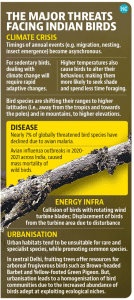1. INDIA-GREECE ANNOUNCES STRATEGIC PARTNERSHIP
TAG: GS 2: INTERNATIONAL RELATIONS
THE CONTEXT: Prime Minister’s visit to Greece is the first visit by an Indian PM in 40 years. The visit saw the two nations upgrading their relationship to a strategic partnership with focus on expanding political, defence & security cooperation.
EXPLANATION:
- The last high-level visit to Greece took place in September 1983 when then Prime Minister Indira Gandhi travelled to the country.
- India and Greece enjoy civilisational ties, which have strengthened in recent years through cooperation in areas like maritime transport, defence, trade and investments and people-to-people ties.
- Discussions during the visit encompassed trade, defence, security, technology, infrastructure, digital payments, shipping, pharma, agriculture, migration, mobility, tourism, skill development, culture, education, and regional and multilateral issues.
- They jointly called for respect for international law, sovereignty, and territorial integrity.
Highlights of the meeting:
- After his arrival at the ancient city, PM laid a wreath at the ‘Tomb of the Unknown Soldier’ in Athens. The Tomb of the Unknown Soldier is a war memorial located in Syntagma Square in Athens, in front of the Old Royal Palace. It is a cenotaph dedicated to the Greek soldiers killed during various wars.
- India and Greece agreed to upgrade bilateral ties to the level of strategic partnership and both the countries will collaborate in the field of defence industry.
- Both sides also set a target of doubling bilateral trade by 2030 and decided to firm up a migration and mobility partnership pact soon to facilitate skilled migration between the two countries.
- Both the countries signed an agreement regarding agricultural production that will also allow for cooperation in research, animal rearing and animal products.
- The two also discussed the great importance of establishing direct flights between Greece and India, noting “great opportunities” in the sectors of tourism as well as economic cooperation in the pharmaceutical and technology sectors.
- They expressed their intent to expand cooperation across various domains, including defence, shipping, science and technology, cyber space, education, culture, tourism, and agriculture.
- They also agreed “that an early finalisation of a Mobility and Migration Partnership Agreement (MMPA) would be mutually beneficial, facilitating in particular the free movement of workforce between the two countries.”
- Both countries underscored their vision of a “free, open, and rules-based Mediterranean Sea and Indo-Pacific,” emphasising adherence to international law, particularly UNCLOS, while respecting sovereignty, territorial integrity, and freedom of navigation.
- Greek Prime Minister described Greece as a “gateway to Europe” for India and extended support for a free trade pact between India and the European Union (EU).
2. PM GATI SHAKTI INITIATIVE
TAG: GS 3: ECONOMY
THE CONTEXT: Recently, the Network Planning Group (NPG) under the PM Gati Shakti initiative has recommended four infrastructure projects.
EXPLANATION:
- Network Planning Group has put forward a recommendation for six infrastructure projects.
The meeting was chaired by the special secretary of the DPIIT logistics division, where various agencies examined and recommended the projects.
- The recommended projects include an inter-state transmission system for renewable energy projects in Ladakh, an elevated railway track along Kanpur Anwarganj-Mandhana, a rail bridge across the Ganga, a rail line between Ajmer and Chittaurgarh, 4-laning of Bijni to Mandi section road, and 4-laning of the Belgaum-Hungsund-Raichur road.
- The project will improve the roads, which will help the local people by bringing down the travel costs, time, and distance. Also, it will promote tourism and socio economic development along the project road.
- The projects aim to provide multimodal connectivity, efficient logistics, and seamless movement of goods and passengers across the country.
- The project is essential to provide smooth and faster connectivity to eastern region from northern region and will boost the economic growth in economically backward regions.
PM GATI SHAKTI
- The Pradhan Mantri Gati Shakti National Master Plan is a huge project worth Rs 100 lakh crore, initiated by the Indian government to transform the country’s infrastructure.
- It was announced on the occasion of the 75th Independence day, 2021 aimed at transforming the infrastructure landscape of India. This plan is supposed to lessen the time taken for infrastructure projects and upgrade India’s competitiveness in the market.
- The project aims to break the inter-ministerial tangles and silos and foster cooperation and integration in the fasttrack implementation of projects.
- The scheme is expected to smooth out the execution of projects across the nation and foster coordination between different ministries engaged with these projects.
Objectives of the Pradhan Mantri Gati Shakti
- To reduce logistics costs and improve supply chains, thereby making products manufactured in India more competitive globally.
- To attract investment from all over the world for improving the infrastructure of the country.
- To address the issue of high logistics and supply chain costs, which account for around 12% of the GDP in India, compared to the global average of 8%.
- To reduce the excessive dependence on road transportation and under-utilisation of waterways, air, and rail networks.
- To consolidate infrastructure projects in specific corridors and enable better coordination among different ministries, states, and departments.
- To facilitate ease of planning and bring down the overall costs of implementation.
- To help resolve the issues of interministerial delays, approval delays, and communication gaps between various stakeholders.
- To achieve infrastructure-led growth by expediting decision-making and timely completion of infrastructure projects.
Targets of the Pradhan Mantri Gati Shakti
- The national highway network will be extended to expand the limit of roadways and touch the 2 lakh-km mark.
- The scheme imagines the making of around 200 new airports, heliports, and water aerodromes to support aviation.
- The limit of railways to move cargo will be expanded to around 1,600 tons by FY25.
- The transmission network for power will be extended to 454,200 circuit km to easy access.
- The scheme intends to increment renewable capacity to 225 GW by FY25 and complete around 17,000 km of gas pipelines.
3. CHANDRAYAAN-3 LAND ON THE NEAR SIDE OF THE MOON
TAG: GS 3: SCIENCE AND TECHNOLOGY
THE CONTEXT: The controlled descent of the Vikram lander of Chandrayaan-3 made it one of the closest approaches of a lunar mission to the moon’s South Pole. However like most of the lunar-landing missions before, Vikram too landed on the near side of the moon.
EXPLANATION:
- Tlll now, the Chinese Chang’e 4 mission is the only one to have landed on the far side.
- This vehicle landed on the Von Karman crater situated within a larger 2,500 km wide crater called the South Pole Aitken basin.
What are the moon’s ‘near’ and ‘far sides’ and ‘dark’ side?
- The near side refers to the portion of the moon that is 60% visible to us. It is always the same side that is visible from Earth because the moon takes the same time to rotate about its axis as it does to circle around the Earth.
- The ‘new moon’ or when the moon is invisible from Earth is the time when the other ‘far side’ of the moon is bathed in sunlight and continues to receive light for nearly a fortnight.
- The ‘dark side’ is thus dark only in the sense that it was mysterious and its various topographical features hidden until the Soviet spacecraft Luna 3 in 1959 photographed it and the Soviet Academy of Sciences released an atlas of these images.
- Astronauts aboard the Apollo 8 mission of 1968 were the first humans to see the far side of the moon.
Is the dark side very different from the near side?
- The major difference between the two sides is that the near side is relatively smoother and has many more ‘maria’ or large volcanic plains compared to the far side.
- On the far side however, there are huge craters, thousands of kilometres wide, which have likely resulted from collisions with asteroids.
- The crust on the near side is thinner because of which, over millions of years, the volcanic lava in the lunar crust has flowed more extensively into the thinner side and filled up its craters.
- The resulting plains that have thus formed are far more conducive to space missions because they provide a relatively flat terrain for landers and rovers.
- Chandrayaan-3 identified an area 2.4 km wide and 4.8 km long that had spots of 150 m spaces that would be conducive to a safe descent.
What’s special about the Chandrayaan-3’s landing?
- The Chandrayaan-3 mission, while still on the near side, has managed to land Vikram the closest ever to the lunar South Pole.
- The coordinates of Chandrayaan-3 at 69.36 S and 32.34 E make it about 600 km away from the South Pole.
- The choice of being as close as possible to the South Pole was to get closer to a “permanently shadowed region” or where no sunlight ever reaches.
- This would mean increasing the chances of encountering frozen water-ice along with several “interesting deposits” that can reveal more about the moon and its harvestable resources.
- The mission’s guiding purpose was to execute a successful controlled or ‘soft landing’ and the chances of doing that best while being near the South Pole were best served by keeping it in the near side.
- Crucially, landing on the far side would have meant no direct, line-of-sight communication with the Earth, necessary for regular near-real-time updates. That is the reason that determined the choice of landing locations.
4. CORALS IN LOW NUTRIENT ZONES
TAG: GS 3: SCIENCE AND TECHNOLOGY
THE CONTEXT: A recent study finds out how the Coral Reefs can thrive in parts of the ocean that are low in nutrients.
EXPLANATION:
- There was a mystery of corals, which puzzled the scientists for centuries, that how coral reefs thrive despite being in low nutrient regions.
- It has inspired the discovery of several important processes that can help to explain this phenomenon. We can now add the missing piece of the puzzle and help to solve the long-running mystery.
HIGHLIGHTS OF THE STUDY:
- Nutrients from the symbionts:
- The symbiotic algae living within the corals are very efficient at taking up dissolved inorganic nutrients, like nitrate and phosphate, from the surrounding seawater.
- Even in nutrient-poor areas of the ocean, these compounds are present in considerable amounts as excretion products of organisms, such as sponges, that live close by.
- Ocean currents can also transport these nutrients to reefs.
- The coral host cannot absorb or use nitrate and phosphate directly, so they digest some of their symbiont population to access the nitrogen and phosphorus that these algae absorb from the water.

Symbiont algae from a reef coral viewed under a microscope.
Nutrients from the bird’s excrements:
- Corals have the potential to farm and feed on their symbiont algae in the wild too.
- The reefs around some of these islands are supplied with substantial amounts of nutrients that come from “guano” – the excrement of seabirds nesting on the islands.
- We found out that growth was more than twice as fast on reefs that were supplied with seabird nutrients.
- About half of the nitrogen molecules in the tissue of the coral animals from islands with seabirds could be traced back to uptake by the symbiont algae.

Reefs around islands in the Indian Ocean receive additional nutrients if the islands are inhabited by seabirds.
If these factors are unavailable to the corals in low nutrient regions, then population of symbiotic algae will cease to exist.
- The coral will undergo bleaching and eventually leading to death.
- Bleaching refers to the white appearance of the corals with low symbiont numbers in their tissue.
- Corals grew fast in nutrient-rich water despite the absence of food (top in diagram).
- Corals in nutrient-depleted water stopped growing and showed a bleached appearance (bottom inn diagram)
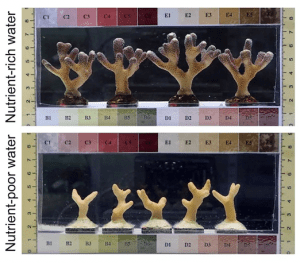
What are corals and how do they get food?
- They are soft-bodied animals made up of many individual polyps that live together as a colony.
- They secrete limestone skeletons that form the foundation of reefs.
- The coral polyps acquire nutritious compounds rich in nitrogen and phosphorus by catching prey like zooplankton with their tentacles.
- Many coral animals are also dependent on a symbiosis a mutually beneficial relationship with the microscopic algae that live inside their cells.
- These photosynthetic algae produce large amounts of carbon-rich compounds, such as sugars, and transfer them to the host coral to generate energy.
- However, as most photosynthetic products are deficient in nitrogen and phosphorous, they cannot sustain the growth of the animals.
- The question as to why coral reefs thrive in parts of the oceans that are poor in nutrients is known as Darwin’s Paradox of Coral Reefs.
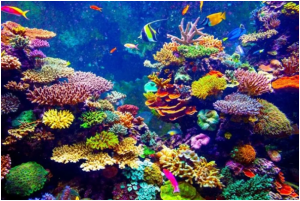
5. STATE OF INDIA’S BIRDS’ REPORT
TAG: GS 3: ECOLOGY AND ENVIRONMENT
THE CONTEXT: The State of India’s Birds 2023, released on August 25, 2023, finds that a few bird species like the Indian peafowl are thriving in India, many species are declining.
EXPLANATION:
- The report is based on 30 million observations contributed by 30,000 birdwatchers across the country.
- The report highlighted major threats to bird populations across the country.
- It listed 178 bird species in the country as being of “High Priority” for immediate conservation action.
- These include migratory wetland birds like the Ruddy shelduck, and resident species such as the Indian courser.
Highlights of the State of India’s Birds 2023:
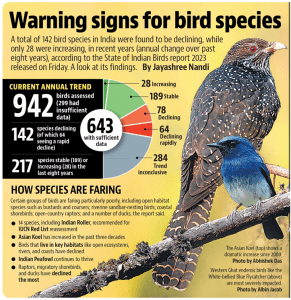
What is the overall decline?
- Of the 338 species that had enough data to assess for long-term trends, 60% of the species showed long-term declines.
- The trends showed that 204 species have declined in the long term, 98 species declined rapidly, 98 species are stable, and 36 species showed increases.
- Of the 359 species analysed for current annual trends, 40% are declining.
- The current trends showed that 142 species are declining (of which 64 are in a “rapid decline”), 189 are stable and 28 are increasing.
- Birds endemic to the Western Ghats and Sri Lanka biodiversity hotspot have rapidly declined in India over the past few decades.
- Birds that feed on vertebrates and carrion including raptors (specifically habitat-specialist raptors such as some harriers and the Short-toed snake eagle), and vultures have declined greatly.
- As per the report, this could be suggestive of harmful pollutants in their food resources, a decline in prey availability, or both.
What are the increases?
- A few generalist bird species such as the national bird – the Indian peafowl, are doing extremely well in the country.
- There has been a 150% increase in the abundance of peafowl across the country over the past decades.
- The good news of the increase is tempered by a recognition of increased reports of crop damage in different parts of the country, and the negative impacts on snakes and other reptiles.
- Therefore, it is important to investigate the impacts of this peafowl boom on both people and ecosystems.
- Other species that are doing remarkably well are the Ashy Prinia, the feral Rock pigeon, and the Asian koel.
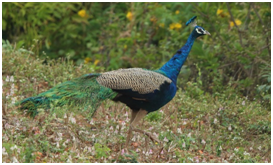
Indian Peafowl.

Ashy Prinia
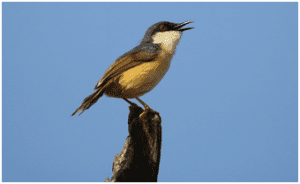
Asian Koel Female
Species of high conservation priority:
- Out of all 942 species, 178 species are classified as High Priority, 323 as Moderate Priority, and 441 as Low Priority.
- The High Priority species include migratory wetland birds like the Ruddy shelduck, resident species such as the Indian courser, endemics such as the Narcondam hornbill and the Nicobar megapode on Nicobar Island.
- Of the High Priority species, 90 are classified as globally of Least Concern by the IUCN Red List 2022.
- The report recommended that 17 of these would qualify for a different IUCN threat status nationally.
- These include the Indian Roller, a grassland and scrub bird which shows a 30% decline in 12 years, and the Northern shoveler, a species of duck that shows a 58% decline in 14 years.
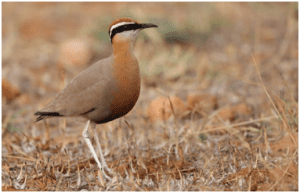
Indian Courser
What are the threats to the birds species?
